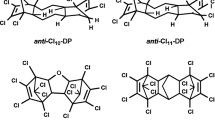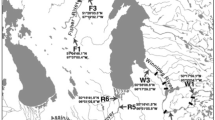Abstract
The relationship between desorption kinetics and bioavailability of sediment-associated 2,2′,4,4,5′ pentabromo diphenyl ether [14C] (BDE-99) and 2,3,7,8 tetrachlorodibenzo(p)dioxin [3H] (TCDD) was examined in the contaminated sediments. The desorption kinetics were measured in a sediment–water suspension using Tenax® extraction, and bioaccumulation was examined by exposing Lumbriculus variegatus (Oligochaeta) to BDE-99 and TCDD spiked sediment in a 14-day kinetic study. Both chemicals had a high affinity to the finest particle size fraction (<20 μm) and the large, very slowly desorbing fraction (58–75%). The biota–sediment accumulation factors ranged between 1.9 and 4.4 for BDE-99 and between 1.4 and 2.8 for TCDD. The chemical outflux from the rapidly desorbing fraction and influx into organisms shows the connection between desorption and bioavailability. Despite this, normalization to the rapidly desorbing fraction was unable to reduce differences in bioavailability estimates between the chemicals. Thus, it is evident that chemical extraction in the mixed system (Tenax tubes) does not fully describe the bioavailable fraction that worms face in stagnant sediments in a similar way for all chemicals. However, when all desorbing domains were included in the calculation, the difference between the chemicals disappears. Desorbing fractions were also able to reduce variability in the biota–sediment accumulation factors between the tested sediments when organic carbon-based sediment chemical concentrations were modified by the desorbing fractions.


Similar content being viewed by others
References
Bärring H, Bucheli TD, Broman D, Gustafsson Ö (2002) Soot-water distribution coefficients for polychlorinated dibenzo-p-dioxins, polyclorinated dibenzofurans and polybrominated diphenylethers determined with the soot cosolvency-column method. Chemosphere 49:515–523. doi:10.1016/S0045-6535(02)00389-2
Birdwell J, Cook RL, Thibodeaux LJ (2007) Desorption kinetics of hydrophobic organic chemicals form sediment to water: a review of data and models. Environ Toxicol Chem 26:424–434. doi:10.1897/06-104R.1
Borglin S, Wilke A, Jepsen R, Lick W (1996) Parameters affecting the desorption of hydrophobic organic chemicals from suspended sediments. Environ Toxicol Chem 15:2254–2262. doi:10.1897/1551-5028(1996)015<2254:PATDOH>2.3.CO;2
Braekevelt E, Tittlemier SA, Tomy GT (2003) Direct measurement of octanol–water partition coefficient of some environmentally relevant brominated diphenyl ether congeners. Chemosphere 51:563–567. doi:10.1016/S0045-6535(02)00841-X
Bucheli TD, Gustafsson Ö (2003) Soot sorption of non-ortho and ortho substituted PCBs. Chemosphere 53:515–522. doi:10.1016/S0045-6535(03)00508-3
Carroll KM, Harkness MR, Bracco AA, Balcacel RR (1994) Application of a permeant/polymer diffusional model to the desorption of polychlorinated biphenyls from Hudson River sediments. Environ Sci Technol 28:253–258. doi:10.1021/es00051a011
Cornelissen G, van Noort PCM, Govers HAJ (1997) Desorption kinetics of chlorobenzenes, polycyclic aromatic hydrocarbons, and polychlorinated biphenyls: sediment extraction with Tenax and effects of contact time and solute hydrophobicity. Environ Toxicol Chem 16:1351–1357. doi:10.1897/1551-5028(1997)016<1351:DKOCPA>2.3.CO;2
Cornelissen G, Rigterink H, van Noort PCM, Govers HAJ (2000) Slowly and very slowly desorbing organic compounds in sediments exhibit langmuir-type sorbtion. Environ Toxicol Chem 19:1532–1539. doi:10.1897/1551-5028(2000)019<1532:SAVSDO>2.3.CO;2
Cornelissen G, Rigterink H, ten Hulscher DEM, Vrind BA, van Noort PCM (2001) A simple tenax extraction method to determine the availability of sediment-sorbed organic compounds. Environ Toxicol Chem 20:706–711. doi:10.1897/1551-5028(2001)020<0706:ASTEMT>2.0.CO;2
Cornelissen G, Kukulska S, Kalaitzidis S, Christanis K, Gustafsson Ö (2004) Relations between environmental black carbon sorption and geochemical sorbent characteristics. Environ Sci Technol 38:3632–3640. doi:10.1021/es0498742
Cuypers C, Grotenhuis T, Nierop KGJ, Franco EM, de Jager A, Rulkens W (2002) Amorphous and condensed organic matter domains: the effect of persulfate oxidation on the composition of soil/sediment organic matter. Chemosphere 48:919–931. doi:10.1016/S0045-6535(02)00123-6
Di Toro DM, Zarb SC, Hansen DJ et al (1991) Technical basis for establishing sediment quality criteria for nonionic organic chemicals using equilibrium partitioning. Environ Toxicol Chem 10:1541–1583. doi:10.1897/1552-8618(1991)10[1541:TBFESQ]2.0.CO;2
Ehlers GAC, Loibner AP (2006) Linking organic pollutant (bio)availability with geosorbent properties and biomimetic methodology: a review of geosorbent characterisation and (bio)availability prediction. Environ Pollut 141:494–512. doi:10.1016/j.envpol.2005.08.063
Feron VJ, Groten JP (2002) Toxicological evaluation of chemical mixtures. Food Chem Toxicol 40:825–839. doi:10.1016/S0278-6915(02)00021-2
Finnish Standards Association (1984) Water quality. Determination of the acute toxicity with waterflea, Daphnia magna Straus. Standard SFS 5062. Helsinki (in Finnish)
Goedkoop W, Peterson M (2003) The fate, distribution, and toxicity of lindane in tests with chironomus riparius: effects of bioturbation and sediment organic matter content. Environ Toxicol Chem 22:67–76. doi:10.1897/1551-5028(2003)022<0067:TFDATO>2.0.CO;2
Greenberg MS, Burton AG, Landrum PF, Leppänen MT, Kukkonen JVK (2005) Desorption kinetics of fluoranthene and trifluralin from Lake Huron and Lake Erie, USA, sediments. Environ Toxicol Chem 24:31–39. doi:10.1897/04-059R.1
Gustafsson Ö, Hagheta F, Chan C, Macfarne J, Gschwend PM (1997) Quantification of the dilute sedimentary soot phase: implications for PAH speciation and bioavailability. Environ Sci Technol 31:203–209. doi:10.1021/es960317s
Hecht SA, Gunnarson JS, Boese BL et al (2004) Influences of sedimentary organic matter quality on the bioaccumulation of 4-nonylphenol by estruarine amphipods. Environ Toxicol Chem 23:865–873. doi:10.1897/03-220
Jonker MT, Hoenderboom AM, Koelmans AA (2004) Effects of sedimentary sootlike materials on bioaccumulation and sorption of polychlorinated biphenyls. Environ Toxicol Chem 23:2563–2570. doi:10.1897/03-351
Kraaij RH, Seinen W, Tolls J, Cornelissen G, Belfroid A (2002a) Direct evidence of sequestration in sediments affecting the bioavailability of hydrophopic organic chemicals to benthic deposit-feeders. Environ Sci Technol 36:3525–3529. doi:10.1021/es0102787
Kraaij RH, Tolls J, Sijm DS, Cornelissen G, Heikens A, Belfroid A (2002b) Effects of contact time on the sequestration and bioavailability of different classes of hydrophobic organic chemicals to benthic oligochaetes (Tubificidae). Environ Toxicol Chem 21:752–759. doi:10.1897/1551-5028(2002)021<0752:EOCTOT>2.0.CO;2
Kukkonen JVK, Landrum PF, Mitra S, Gossiaux DC, Gunnarson J, Weston D (2003) Sediment characteristics affecting desorption kinetics of select PAH and PCB congeners for seven laboratory spiked sediments. Environ Sci Technol 37:4656–4663. doi:10.1021/es0342594
Kukkonen JVK, Landrum PF, Mitra S, Gossiaux DC, Gunnarsson J, Weston D (2004) The role of desorption for describing the bioavailability of select polycyclic aromatic hydrocarbon and polychlorinated biphenyl congeners for seven laboratory-spiked sediments. Environ Toxicol Chem 23:1842–1851. doi:10.1897/03-474
Lacey R, Watzin MC, McIntosh AW (1999) Sediment organic matter content as confounding factor in toxicity tests with Chironomus tentans. Environ Toxicol Chem 18:231–236. doi:10.1897/1551-5028(1999)018<0231:SOMCAA>2.3.CO;2
Landrum PF (1989) Bioavailability and toxicokinetics of polycyclic aromatic hydrocarbons sorbed to sediments for the amphipod Pontoporeia hoyi. Environ Sci Technol 23:588–595. doi:10.1021/es00063a012
Legind CN, Karlson U, Burken JG, Reichenberg F, Mayer P (2007) Determining chemical activity of (semi)volatile compounds by headspace solid-phase microextraction. Anal Chem 79:2869–2876. doi:10.1021/ac061880o
Leppänen MT, Kukkonen JVK (1998a) Relative importance of ingested sediment and pore water as bioaccumulation routes for pyrene to oligochaete (Lumbriculus variegatus, Müller): implications for sediment toxicity testing. Environ Sci Technol 32:1503–1508. doi:10.1021/es970941k
Leppänen MT, Kukkonen JVK (1998b) Factors affecting feeding rate, reproduction and growth of an oligochaete Lumbriculus variegatus (Müller). Hydrobiologia 377:183–194. doi:10.1023/A:1003252520704
Leppänen MT, Kukkonen JVK (2004) Toxicokinetics of sediment-associated polybrominated diphenylethers (flame retardants) in benthic invertebrates (Lumbriculus variegatus, oligochaeta). Environ Toxicol Chem 23:166–172. doi:10.1897/03-68
Leppänen MT, Kukkonen JVK (2006) Evaluating the role of desorption in bioavailability of sediment-associated contaminants using oligochaetes, semipermeable membrane devices and Tenax extraction. Environ Pollut 140:150–163. doi:10.1016/j.envpol.2005.06.010
Loonen H, Muir DCG, Parsons JR, Govers HAJ (1997) Bioaccumulation of polychlorinated dibenzo-p-dioxins in sediment by oligochaetes: influence of exposure pathway and contact time. Environ Toxicol Chem 16:1518–1525. doi:10.1897/1551-5028(1997)016<1518:BOPDPD>2.3.CO;2
Luthy RG, Aiken GR, Brusseu ML et al (1997) Sequestration of hydrophobic organic contaminants by geosorbents. Environ Sci Technol 31:3341–3347. doi:10.1021/es970512m
Lyytikäinen M, Hirva P, Minkkinen P et al (2003) Bioavailability of sediment-associated PCDD/Fs and PCDEs: relative importance of contaminant and sediment characteristics and biological factors. Environ Sci Technol 37:3926–3934. doi:10.1021/es034151o
MacKay D, Shiu WY, Ma K-C, Lee SC (2006) Handbook of physical-chemical properties and environmental fate for organic chemicals, 2nd edn. Taylor & Francis, Boca Raton, FL
Malve O, Salo S, Verta M, Fortius J (2003) Modelling the transport of PCDD/F compounds in a contaminated river and the possible influence of restoration dredging on calculated fluxes. Environ Sci Technol 37:3413–3421. doi:10.1021/es0260723
Mayer P, Vaes WHJ, Winjker F et al (2000) Sensing dissolved sediment porewater concentrations of persistent and bioaccumulative pollutants using disposable solid-phase microextraction fibers. Environ Sci Technol 34:5177–5183. doi:10.1021/es001179g
Moermond CTA, Zwolsman JJG, Koelmans AA (2005) Black carbon and ecological factors affect in situ biota to sediment accumulation factors for hydrophobic organic compounds in flood plain lakes. Environ Sci Technol 39:3101–3109. doi:10.1021/es048079l
Mount DR, Dawson TD, Burkhard LP (1999) Implications of gut purging for tissue residues determined in bioaccumulation testing of sediment with Lumbriculus variegatus. Environ Toxicol Chem 18:1244–1249. doi:10.1897/1551-5028(1999)018<1244:IOGPFT>2.3.CO;2
Paasivirta J, Sinkkonen S, Mikkelson P, Rantio T, Wania F (1999) Estimation of vapor pressures, solubilities and Henry’s law constants of selected persistent organic pollutants as functions of temperature. Chemosphere 39:811–832. doi:10.1016/S0045-6535(99)00016-8
Parrish CC (1999) Determination of total lipid, lipid classes, and fatty acids in aquatic samples. In: Arts MT, Wainmann BC (eds) Lipids in freshwater ecosystems. Springer-Verlag, New York, pp 4–20
Pignatello JJ, Xing B (1996) Mechanisms of slow sorption of organic chemicals to natural particles. Environ Sci Technol 30:1–11. doi:10.1021/es940683g
Rockne KJ, Shor JM, Young LY, Taghon GL, Kosson DS (2002) Distributed sequestration and release of PAHs in weathered sediment: the role of sediment structure and organic carbon properties. Environ Sci Technol 36:2636–2644. doi:10.1021/es015652h
Schrock ME, Barrows ES, Rosman LB (1997) Biota-to-sediment accumulation factors for TCDD and TCDF in worms from 28-day bioaccumulation tests. Chemosphere 34:1333–1339. doi:10.1016/S0045-6535(97)00430-X
Schwarzenbach RP, Gschend PM, Imboden DM (2003) Environmental organic chemistry, 2nd edn. Wiley, Hoboken, NJ
Sormunen AJ, Koistinen J, Leppänen MT, Kukkonen JVK (2008a) Desorption of sediment-associated polychlorinated dibenzo-p-dioxins, dibenzofurans, diphenyl ethers and hydroxydiphenyl ethers from contaminated sediment. Chemosphere 72:1–7. doi:10.1016/j.chemosphere.2008.02.057
Sormunen AJ, Leppänen MT, Kukkonen JVK (2008b) Influence of sediment ingestion and exposure concentration on the bioavailable fraction of sediment-associated tetrachlorobiphenyl in Oligochaetes. Environ Toxicol Chem 27:854–863. doi:10.1897/07-334.1
Swartz RC, Ferraro SP, Lamberson JO et al (1997) Photoactivation and toxicity of mixtures of polycyclic aromatic hydrocarbon compounds in marine sediment. Environ Toxicol Chem 16:2151–2157. doi:10.1897/1551-5028(1997)016<2151:PATOMO>2.3.CO;2
ten Hulscher ThEM, Vrind BA, van den Heuvel H et al (1999) Triphasic desorption of highly resistant chlorobenzenes, polychlorinated biphenyls, and polycyclic aromatic hydrocarbons in field contaminated sediments. Environ Sci Technol 33:126–132. doi:10.1021/es980091o
ten Hulscher ThEM, Vrind BA, van Noort PC, Govers HAJ (2002) Resistant sorption of in situ chlorobenzenes and a polychlorinated biphenyl in river Rhine suspended matter. Chemosphere 49:1231–1238. doi:10.1016/S0045-6535(02)00606-9
van den Heuvel H, van Noort PCM (2003) Competition for adsorption between added phenantrene and in situ PAHs in two sediments. Chemosphere 53:1097–1103. doi:10.1016/S0045-6535(03)00596-4
van Noort PC, Jonker MT, Koelmans AA (2004) Modelling maximum adsorption capacities of soot and soot-like materials for PAHs and PCBs. Environ Sci Technol 38:3305–3309. doi:10.1021/es035120w
Voparil IM, Burgess RM, Mayer LM, Tien R, Cantwell MG, Ryba S (2004) Digestive bioavailability to a deposit feeder (Arenicola marina) of polycyclic aromatic hydrocarbons associated with anthropognenic particles. Environ Toxicol Chem 23:2618–2626. doi:10.1897/03-357
Weston DP, Mayer LM (1998) In vitro digestive fluid extraction as a measure of the bioavailability of sediment-associated polycyclic aromatic hydrocarbons: sources of variation and implications for partitioning models. Environ Toxicol Chem 17:820–829. doi:10.1897/1551-5028(1998)017<0820:IVDFEA>2.3.CO;2
Weston DP, Maruya KA (2002) Predicting bioavailability and bioaccumulation with in vitro digestive fluid extraction. Environ Toxicol Chem 21:962–971. doi:10.1897/1551-5028(2002)021<0962:PBABWI>2.0.CO;2
Weber WJ, Huang W (1996) A distributed reactivity model for sorption by soils and sediments. 4. Intraparticle heterogeneity and phase-distribution relationships under nonequilibrium conditions. Environ Sci Technol 30:881–888. doi:10.1021/es950329y
Weber WJ, Kim SH, Johnson MD (2002) Distributed reactivity model for sorption by soils and sediments. 15. High-concentration co-contaminant effects on phenanthrene sorption and desorption. Environ Sci Technol 36:3625–3634. doi:10.1021/es020557+
White JC, Pignatello JJ (1999) Influence of disolute competition on the desorption kinetics of polycyclic aromatic hydrocarbons in soil. Environ Sci Technol 33:4292–4298. doi:10.1021/es990537g
Zhao D, Hunter M, Pignatello JJ, White JC (2002) Application of the dual-mode model for predicting competitive sorption equilibria and rates of polycyclic hydrocarbons in estuarine sediment suspensions. Environ Toxicol Chem 21:2276–2282. doi:10.1897/1551-5028(2002)021<2276:AOTDMM>2.0.CO;2
Acknowledgments
The study was funded by the Academy of Finland (projects 206071 and 214545) and the European Union-funded project Modelkey (511237-GOCE). Dr. Paul van Noort is acknowledged for providing the Lake Ketelmeer sediment sample. Further, thanks are due to Mrs. Anita Tuikka for her technical assistance.
Author information
Authors and Affiliations
Corresponding author
Rights and permissions
About this article
Cite this article
Sormunen, A.J., Leppänen, M.T. & Kukkonen, J.V.K. Desorption and Bioavailability of Spiked Pentabromo Diphenyl Ether and Tetrachlorodibenzo(p)dioxin in Contaminated Sediments. Arch Environ Contam Toxicol 56, 670–679 (2009). https://doi.org/10.1007/s00244-008-9222-6
Received:
Accepted:
Published:
Issue Date:
DOI: https://doi.org/10.1007/s00244-008-9222-6




